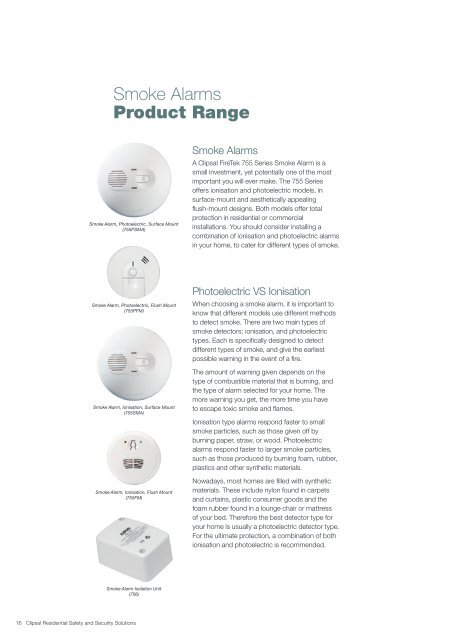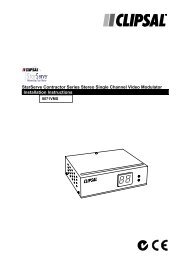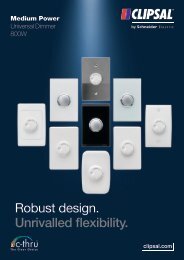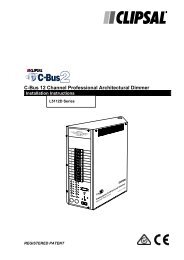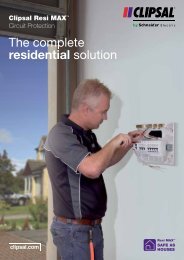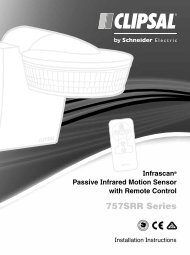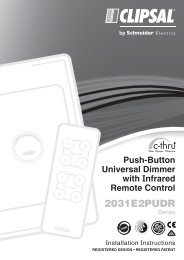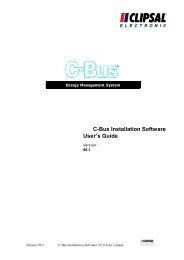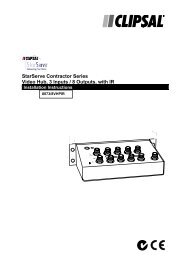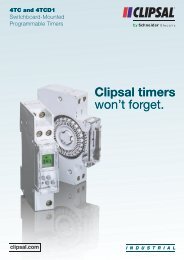Clipsal Residential Safety and Security Solutions, 25611 (3521 KB)
Clipsal Residential Safety and Security Solutions, 25611 (3521 KB)
Clipsal Residential Safety and Security Solutions, 25611 (3521 KB)
You also want an ePaper? Increase the reach of your titles
YUMPU automatically turns print PDFs into web optimized ePapers that Google loves.
Smoke Alarms<br />
Product Range<br />
Smoke Alarm, Photoelectric, Surface Mount<br />
(755PSMA)<br />
Smoke Alarms<br />
A <strong>Clipsal</strong> FireTek 755 Series Smoke Alarm is a<br />
small investment, yet potentially one of the most<br />
important you will ever make. The 755 Series<br />
offers ionisation <strong>and</strong> photoelectric models, in<br />
surface-mount <strong>and</strong> aesthetically appealing<br />
flush-mount designs. Both models offer total<br />
protection in residential or commercial<br />
installations. You should consider installing a<br />
combination of ionisation <strong>and</strong> photoelectric alarms<br />
in your home, to cater for different types of smoke.<br />
Smoke Alarm, Photoelectric, Flush Mount<br />
(755PFM)<br />
Smoke Alarm, Ionisation, Surface Mount<br />
(755SMA)<br />
Smoke Alarm, Ionisation, Flush Mount<br />
(755FM)<br />
Photoelectric VS Ionisation<br />
When choosing a smoke alarm, it is important to<br />
know that different models use different methods<br />
to detect smoke. There are two main types of<br />
smoke detectors: ionisation, <strong>and</strong> photoelectric<br />
types. Each is specifically designed to detect<br />
different types of smoke, <strong>and</strong> give the earliest<br />
possible warning in the event of a fire.<br />
The amount of warning given depends on the<br />
type of combustible material that is burning, <strong>and</strong><br />
the type of alarm selected for your home. The<br />
more warning you get, the more time you have<br />
to escape toxic smoke <strong>and</strong> flames.<br />
Ionisation type alarms respond faster to small<br />
smoke particles, such as those given off by<br />
burning paper, straw, or wood. Photoelectric<br />
alarms respond faster to larger smoke particles,<br />
such as those produced by burning foam, rubber,<br />
plastics <strong>and</strong> other synthetic materials.<br />
Nowadays, most homes are filled with synthetic<br />
materials. These include nylon found in carpets<br />
<strong>and</strong> curtains, plastic consumer goods <strong>and</strong> the<br />
foam rubber found in a lounge chair or mattress<br />
of your bed. Therefore the best detector type for<br />
your home is usually a photoelectric detector type.<br />
For the ultimate protection, a combination of both<br />
ionisation <strong>and</strong> photoelectric is recommended.<br />
Smoke Alarm Isolation Unit<br />
(756)<br />
16 <strong>Clipsal</strong> <strong>Residential</strong> <strong>Safety</strong> <strong>and</strong> <strong>Security</strong> <strong>Solutions</strong>


